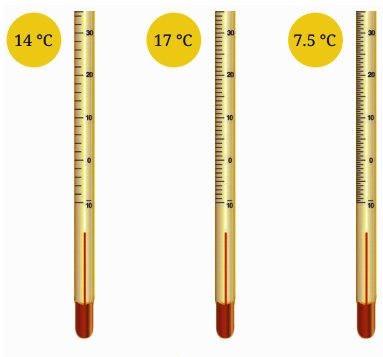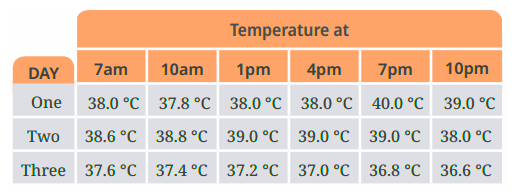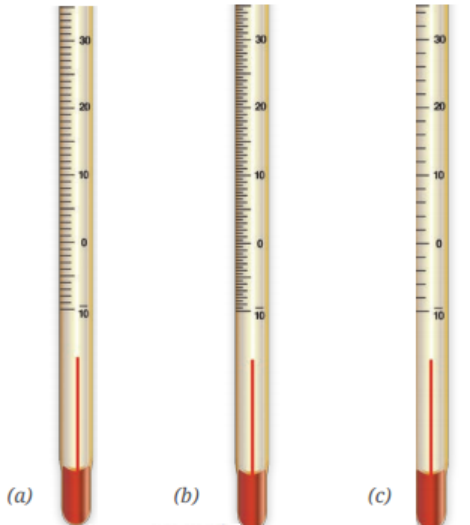How To Learn Temperature And Its Measurement Class 6 Questions And Answers Effectively?
Temperature and its measurement class 6 questions and answers help students learn about heat and thermometers. This chapter explains how we measure temperature in daily life.
 Table of Content
Table of ContentThese solutions help students prepare for exams without stress. Every concept is explained with examples and diagrams. Download the NCERT Solutions PDF for free and improve your Science grades today.
Vedantu offers clear solutions for every exercise question in this chapter. Students can also check NCERT Solutions Class 6 Science for other topics. Each answer is written in simple steps that students can follow easily.
How To Learn Temperature And Its Measurement Class 6 Questions And Answers Effectively For Exam Preparation
Question 1. The normal temperature of a healthy human being is close to
(i) 98.6 °C
(ii) 37.0 °C
(in) 32.0 °C
(iv) 27.0 °C
Answer: (ii) 37.0 °C
Question 2. 37 °C is the same temperature as
(i) 97.4 °F
(ii) 97.6 °F
(iii) 98.4 °F
(iv) 98.6 °F
Answer: (iv) 98.6 °F
Question 3. Fill in the blanks:
(i) The hotness or coldness of a system is determined by its _________
(ii) The temperature of ice-cold water cannot be measured by a _________ thermometer.
(iii) The unit of temperature is degree _________
Answer:
(i) temperature
(ii) clinical
(iii) Celsius
Question 4. The range of a laboratory thermometer is usually
(i) 10 °C to 100 °C
(ii) -10 °C to 110 °C
(iii) 32 °C to 45 °C
(iv) 35 °C to 42 °C
Answer: (ii) -10 °C to 110 °C
Question 5. Four students used a laboratory thermometer to measure the temperature of water as shown in Fig. below

Who do you think followed the correct way for measuring temperature?
(i) Student 1
(ii) Student 2
(iii) Student 3
(iv) Student 4
Answer: Student 2
Question 6. Colour to show the red column on the drawings of thermometers (Fig. below) as per the temperatures written below:

Answer:
For 14 °C, colour up to two small lines above the 10 °C mark (each line represents 2 degrees Celsius).
For 17 °C, colour up to seven small lines above the 10 °C mark (each line represents 1 degree Celsius).
For 15 °C, colour up to fifteen small lines above the 0 °C mark (each line represents 0.5 degree Celsius). Red lines are indicated alongside the respective thermometers for clarity.
Question 7. Observe the part of the thermometer shown in Fig. and answer the following questions:

(i) What type of thermometer is it?
(ii) What is the reading of the thermometer?
(in) What is the smallest value that this thermometer can measure?
Answer:
(i) This is a laboratory thermometer, as it has a measuring range from -10 °C to 110 °C.
(ii) The thermometer reading is 26 °C.
(iii) The smallest value this thermometer can measure is -10 °C, with 10 small lines representing each degree between any 10-degree intervals.
Question 8. A laboratory thermometer is not used to measure our body temperature. Give a reason.
Answer: A laboratory thermometer is not used to measure human body temperature for two reasons:
A laboratory thermometer is not suitable for measuring body temperature because:
(i) It is designed for a wider temperature range and requires direct observation, which is inconvenient for use inside the mouth or under the armpit.
(ii) The calibration and scale are not as precise for the narrow range of human body temperature compared to clinical thermometers.
Question 9. Vaishnavi has not gone to school as she is ill. Her mother has kept a record of her body temperature for three days as shown in the Table below

Table: Body temperature record of Vaishnavi
(i) What was Vaishnavi’s highest recorded temperature?
(ii) On which day and at what time was Vaishnavi’s highest temperature recorded?
(iii) On which day did Vaishnavi’s temperature return to normal?
Answer:
(i) 40.0 °C
(ii) Day one 7 pm
(iii) Day three
Question 10. If you have to measure the temperature 22.5 °C, which of the following three thermometers will you use (Fig.)? Explain.

Three thermometers
Answer: You should use a thermometer (b). Thermometer (a) can measure temperatures with a precision of 1°C, and thermometer (c) can measure with a precision of 2°C, based on their small line markings. Thermometer (b) is the only one with markings that allow for a precision of 0.5°C, which is needed to accurately measure 22.5 °C.
Question 11. The temperature shown by the thermometer in Fig. is

(i) 28.0 °C
(ii) 27.5 °C
(iii) 26.5 °C
(iv) 25.3 °C
Answer: (ii) 27.5 °C
Question 12. A laboratory thermometer has 50 divisions between 0°C and 100°C. What does each division of this thermometer measure?
Answer: 2°C
Question 13. Draw the scale of a thermometer in which the smallest dimension reads 0.5 °C. You may draw only the portion between 10 °C and 20 °C.
Answer:

Question 14. Someone tells you that she has a fever of 101 degrees. Does she mean it on the Celsius scale or Fahrenheit scale?
Answer: She means the temperature on the Fahrenheit scale. Human body temperature does not normally go below 35 °C or above 42 °C. In the Fahrenheit scale this range is between 95 degrees to 107.8 degrees.
Benefits of NCERT Solutions for Class 6 Science Chapter 7 Temperature and its Measurement
Students learn to differentiate between hot and cold based on temperature measurements rather than relying on touch.
The activities provide hands-on experience in measuring temperature, making the learning process more engaging.
Students become familiar with the different types of thermometers and their specific uses, such as clinical and laboratory thermometers.
Important Study Material Links for Science Chapter 7 Class 6
S. No | Important Study Material Links for Chapter 7 |
1. | Class 6 Temperature and its Measurement Important Questions |
2. | |
3. | Class 6 Temperature and its Measurement Worksheet |
Conclusion
Class 6 Science Chapter 7 Temperature and its Measurement,is essential for students to understand how temperature affects our daily lives, from monitoring body temperature to understanding weather patterns. Chapter 7 equips students with the skills to measure temperature accurately and the knowledge of using different types of thermometers. Through practical activities and real-life applications, students gain valuable insights into the significance of temperature in both health and science.
Chapter-wise NCERT Solutions Class 6 Science
After familiarising yourself with the Class 6 Science Chapter 7 Question Answers, you can access comprehensive NCERT Solutions from all Class 6 Science textbook chapters.
S. No | Class 6 Science Chapter Wise NCERT Solutions links |
1 | |
2 | |
3 | Chapter 3: Mindful Eating: A Path to a Healthy Body Solutions |
4 | |
5 | |
6 | |
7 | |
8 | |
9 | Chapter 10: Living Creatures: Exploring their Characteristics Solutions |
10 | |
11 |
Related Important Links for Class 6 Science
Along with this, students can also download additional study materials provided by Vedantu for Science Class 6-
S. No | Important Links for Class 6 Science |
1. | |
2. | |
3. | |
4. | |
5. |
























